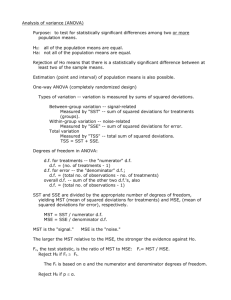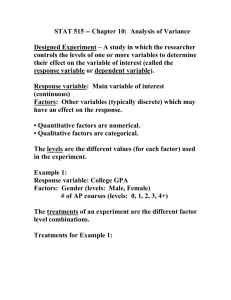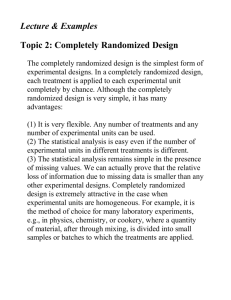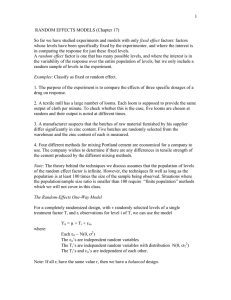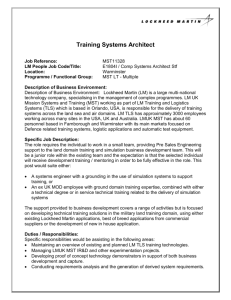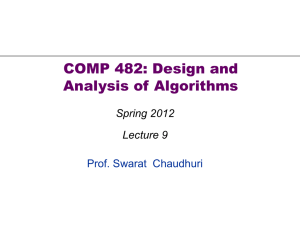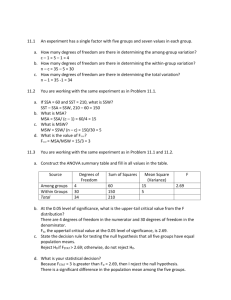Analysis of Variance: Equality of Several Populations
advertisement
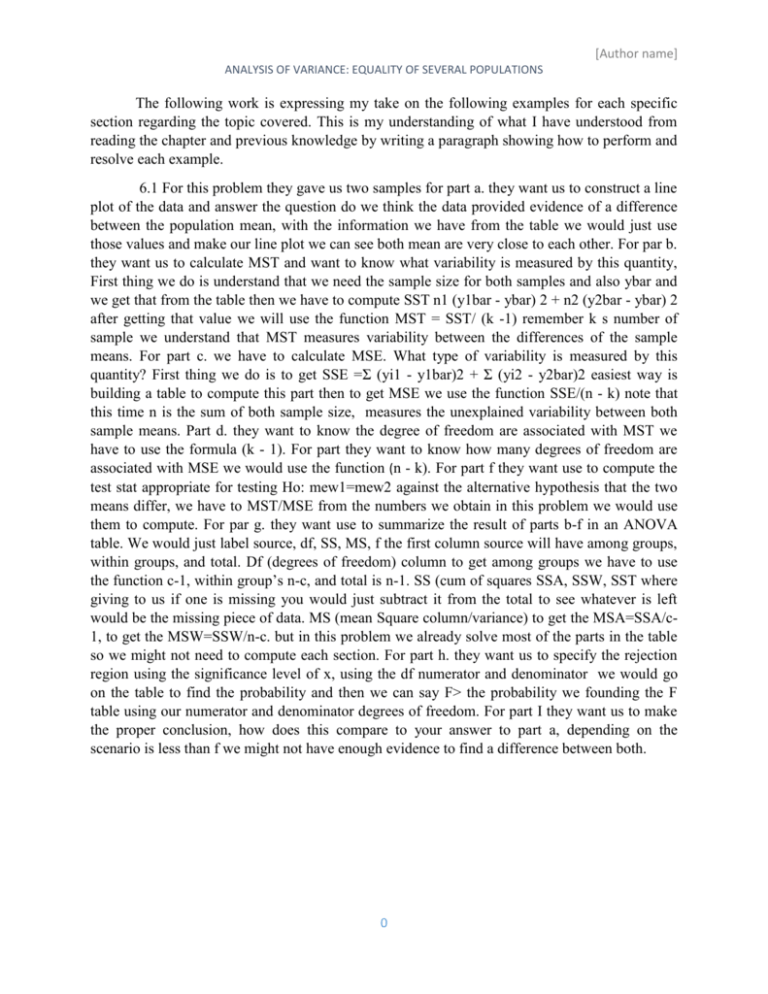
[Author name] ANALYSIS OF VARIANCE: EQUALITY OF SEVERAL POPULATIONS The following work is expressing my take on the following examples for each specific section regarding the topic covered. This is my understanding of what I have understood from reading the chapter and previous knowledge by writing a paragraph showing how to perform and resolve each example. 6.1 For this problem they gave us two samples for part a. they want us to construct a line plot of the data and answer the question do we think the data provided evidence of a difference between the population mean, with the information we have from the table we would just use those values and make our line plot we can see both mean are very close to each other. For par b. they want us to calculate MST and want to know what variability is measured by this quantity, First thing we do is understand that we need the sample size for both samples and also ybar and we get that from the table then we have to compute SST n1 (y1bar - ybar) 2 + n2 (y2bar - ybar) 2 after getting that value we will use the function MST = SST/ (k -1) remember k s number of sample we understand that MST measures variability between the differences of the sample means. For part c. we have to calculate MSE. What type of variability is measured by this quantity? First thing we do is to get SSE =Σ (yi1 - y1bar)2 + Σ (yi2 - y2bar)2 easiest way is building a table to compute this part then to get MSE we use the function SSE/(n - k) note that this time n is the sum of both sample size, measures the unexplained variability between both sample means. Part d. they want to know the degree of freedom are associated with MST we have to use the formula (k - 1). For part they want to know how many degrees of freedom are associated with MSE we would use the function (n - k). For part f they want use to compute the test stat appropriate for testing Ho: mew1=mew2 against the alternative hypothesis that the two means differ, we have to MST/MSE from the numbers we obtain in this problem we would use them to compute. For par g. they want use to summarize the result of parts b-f in an ANOVA table. We would just label source, df, SS, MS, f the first column source will have among groups, within groups, and total. Df (degrees of freedom) column to get among groups we have to use the function c-1, within group’s n-c, and total is n-1. SS (cum of squares SSA, SSW, SST where giving to us if one is missing you would just subtract it from the total to see whatever is left would be the missing piece of data. MS (mean Square column/variance) to get the MSA=SSA/c1, to get the MSW=SSW/n-c. but in this problem we already solve most of the parts in the table so we might not need to compute each section. For part h. they want us to specify the rejection region using the significance level of x, using the df numerator and denominator we would go on the table to find the probability and then we can say F> the probability we founding the F table using our numerator and denominator degrees of freedom. For part I they want us to make the proper conclusion, how does this compare to your answer to part a, depending on the scenario is less than f we might not have enough evidence to find a difference between both. 0 [Author name] ANALYSIS OF VARIANCE: EQUALITY OF SEVERAL POPULATIONS 6.2 They gave us 3 samples on a table and also an analysis of variance procedure with information for part a-e we can find the answer on the data they are just asking to find them in the information provided we can check on problem 6.1 where each part is located as reference. For part f they just want us to build the ANOVA table is easy we did it in problem 6.1 most of the data is giving is just fill in the blank or we can follow the steps by just labeling source, df, SS, MS, f the first column source will have among groups, within groups, and total. Df (degrees of freedom) column to get among groups we have to use the function c-1, within group’s n-c, and total is n-1. SS (cum of squares SSA, SSW, SST where giving to us if one is missing you would just subtract it from the total to see whatever is left would be the missing piece of data. MS (mean Square column/variance) to get the MSA=SSA/c-1, to get the MSW=SSW/n-c. Like I said before some information is giving there might me no need to solve some parts. Part g. they want us to specify the rejection region, and they gave us a level of significance same process as problem 6.1 use our numerator and denominator degree of freedom and find the probability in the F-Table and then we say that F> then the probability we got from the table. For part h. they want us to state the proper conclusion we understand that the value is less than the probability that we found in part g. we fail to reject the null remember if it was greater than the probability we would reject the null it depended on the scenario, but still we don’t have enough evidence to explain that the sample mean are different. They want us to compute P-value and do we agree with answer part, 1 - p (Z < F-Statistic) and we would get the probability value and we would have the same conclusion as part h. 6.3 This scenario they gave us a printout of the SPSS so all the data is there from ANOVA table. For part a. they want us to give the null and alternative hypothesis appropriate for this analysis because we have different samples Ho: = all the sample means Ha at least two means are different. For part b they want us to compute tstat by F = MST/MSE and we would get the value remember all the values are in the printout. For part c. Do the data provide evidence of a difference in mean starting among the x number of sample we would get this answer from our printout p-value location. For part d. they want us to estimate the difference between the mean and they gave us a confidence level first thing we need is to compute SST we would need to build the table to get some of the variable after that we would use the function n1(y1bar - ybar)2 + n2 (y2bar - ybar)2, after that the MST we would use the function SST/(k -1) we also need the SSE by Σ (yi1 - y1bar)2 + Σ (yi2 - y2bar)2 also the MSE= SSE/(n - k) After gathering the information we will compute the tstat by F = MST/MSE. To find the degree of freedom from both MST has (k - 1), MSE has (n - k) then we will use the F-Table to find the probability and we will fail to reject the null because the value is less than the probability we got. 1

